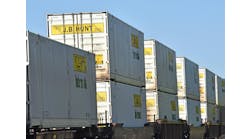Logistics Expectations in North America Are Promising for 2024
In the latest survey, State of the North American Supply Chain, from Averitt, 1400 shippers from various sectors shared their insights on logistics and supply chain management.
Here are some of their findings:
Freight Volume
When asked if they expected to handle more freight volume in 2024 than in 2023, 67% said that are anticipating more freight. Compared to last year’s survey this was a four-percentage point gain.
The study noted that “though the general economy in the U.S. remained resilient throughout 2023, the swift and steep decline in shipping volume was felt within the freight transportation sector. Many players in the industry were forced to close their doors, including Yellow Corporation and Convoy Inc., which made headlines week after week. The bigger question ahead for shippers and the general economy is whether we are entering a period of traditional and sustainable growth compared to the pandemic bubble, which deflated."
Rail and Air
When asked if they planned to use air cargo services in 2024, 26% said yes. This marked a three-percentage-point increase from the previous year.
In addition to the 26% of respondents who were almost certain they would use air services in 2024, 20% of shippers are also interested in or considering using this mode.
Following a similar pattern of anticipated growth, rail (or intermodal service) service use is also expected to increase, by 3 percentage points. From projections of 17% in 2023 to 20% in 2024, interest in rail services returns to a level not seen since the question was asked in 2019, the year before the pandemic.
The report's analysis is as follows:
Last year saw the first major railroad merger in more than two decades. The formation of CPKC brought together Canadian Pacific and Kansas City Southern to form the first transnational rail network on the continent. With a footprint that spans across Canada, the U.S., and Mexico, the merged CPKC comes at a time when more businesses are nearshoring operations to Mexico.
Though the new line promises to increase transportation efficiency with cross-border trade, challenges with increased migration across the U.S.–Mexico border also led to suspensions of vital rail service operations in Texas port cities such as El Paso and Eagle Pass, in December. There may be challenges ahead for cross-border rail service, but there are also further investments in infrastructure that will entice more shippers to use the mode. Late last year, for example, Georgia Ports Authority announced plans to open a second inland rail terminal in Gainesville, Georgia, that will link to the Port of Savannah.
Water
When asked which coasts shippers would move cargo through in 2024, their responses indicated a small decline for East Coast ports of 2 percentage points from 2023 (48%) to 2024 (46%) and increases for West Coast and Gulf Coast ports.
For West Coast ports, there was a positive rebound of 4 percentage points over 2023 expectations, which came off the heels of a steep 10-percentage-point decline in 2022. That year, many shippers shifted cargo elsewhere due to the extreme congestion along the West Coast that occurred in 2021.
For Gulf Coast ports, the survey recorded a 3-percentage-point gain for 2024 (25%) over 2023 (22%)
The report's analysis is as follows:
When looking beyond shippers’ pandemic-year expectations for 2022, the data does not appear to be too surprising. Given most shippers who took the survey are located east of the Mississippi River, it is expected that the East Coast would surpass the West Coast for cargo moves.
However, the lower expectation for the East Coast versus the higher expectation for the West and Gulf Coasts suggests possible hesitation by some shippers that may have to do with the drought-hit Panama Canal. As a result of recent droughts across the Isthmus of Panama, canal authorities have been forced to reduce the number of ships that can transit at any given time. This has led to delays for some ships originating from Asia bound for the East Coast.
Additionally, tensions across the Middle East, particularly around the Suez Canal, could cause additional shipping disruptions to East Coast volumes in the months ahead. On the other hand, Gulf Coast ports fared better over the course of 2023 thanks in part to exports of raw materials, which helped offset the effects of import declines.



